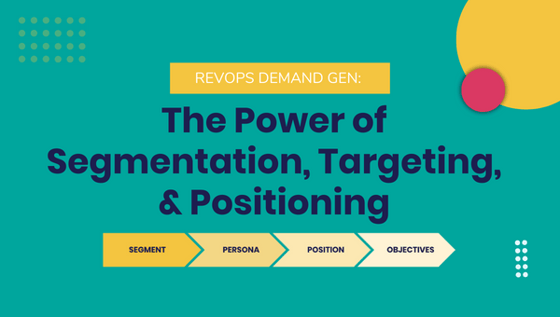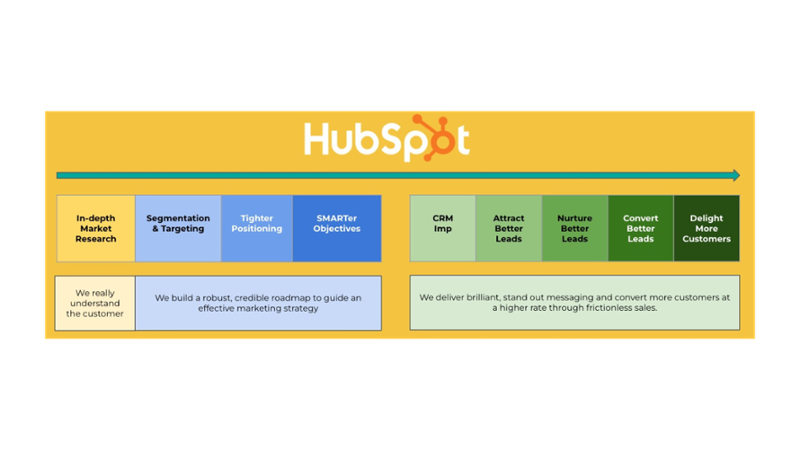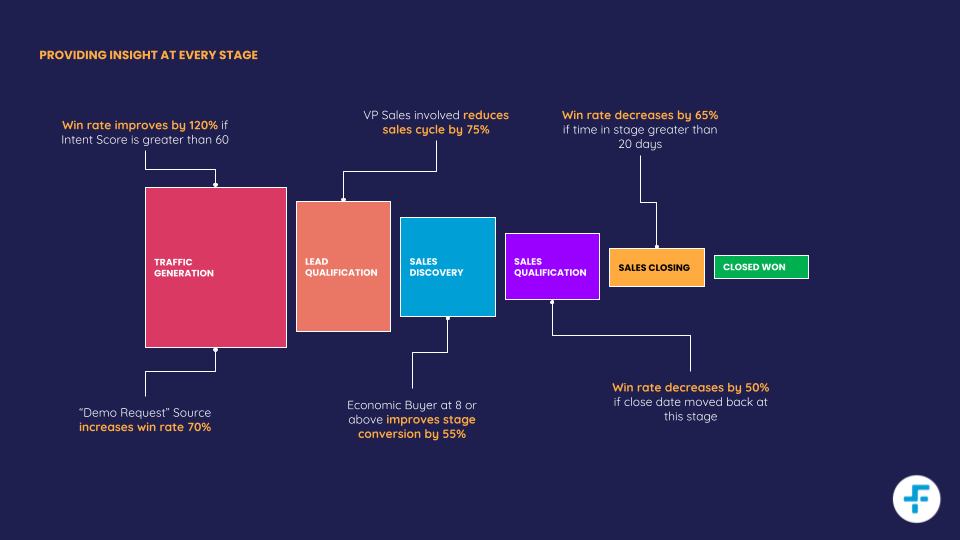


RevOps Demand Gen: The Power of Segmentation, Targeting, & Positioning




To launch a successful marketing campaign, you've got to have your ducks in a row. That means making sure you've got your segmentation, targeting, and positioning (STP) game on point.
Segmentation
First things first: segmentation. You can't just go shooting blindly into the market without a clue as to who you're targeting. Segmenting your market involves dividing it up into specific groups, each with its own unique set of characteristics and needs. This helps you tailor your marketing message to the right people at the right time.
Why bother with segmentation, you ask? Plus, That's a surefire way to end up with a bland and ineffective campaign that doesn't drive revenue.
The importance of segmentation
Marketing orientation demands it:
For one, it's just good marketing sense. You can't be all things to all people, so it's better to focus your resources on the groups that are most likely to buy your product or service.
Avoids the “dangerous” average:
Segmentation exists to differentiate the needs and wants of your market and it helps you avoid the dangerous trap of averaging out your message to try and appeal to everyone.
Focuses your resources:
We must focus our resources where they matter most. After all, our sales are not evenly spread. If 60% of our sales come from just 5% of our customers, we better adapt our strategy to maximise results with the limited resources we have.
Targeting
Once you've got your market segmented, it's time to target. This means deciding which segments you're going to focus on, and which you'll leave for another day. You can't target everyone, so you've got to be strategic about it. Focus on the segments that are most likely to convert, and tailor your message accordingly.
With the landscape mapped, it’s now time to make the crucial decision of whom you will (and more importantly will not) dedicate resources to converting.
We don't want to be spreading our resources too thin by targeting a large audience group. We want to be strategic and focused, knowing who we could and ultimately will sell too, to maximise results.
Imagine you had the potential to service 9 possible segments but only had 1x Time, 2x Budget and 2x Resource tokens to allocate.You couldn’t service everybody and would need to be prudent in where best to deploy your efforts.
If you were to try and target a large audience group with your limited resources, it’s likely that your resources would be spread too thin, your message would become too generic, and results would take longer to achieve.
Positioning
With targets in place, you must research your audience so you can deliver the right message to the right people at the right time to sell more.
“Positioning is not what you do to the product, it's what you do to the mind of the customer. It’s how you differentiate your brand in their mind.” (Source, Al Ries & Jack Trout)
But positioning isn’t saying the most obvious thing in the simplest way. It’s about finding a common ground between three key areas:
- Your customer needs
- What your business can deliver
- The value your competition already offers
Having a strategy is critical for CRM implementation success
Now, when it comes to implementing a CRM system, you've got to keep your STP game in mind. Your CRM is a powerful tool that can help you manage your interactions with customers and prospects.
A well implemented CRM system helps you generate, capture and convert more prospects.
But it will be most effective if it is tailored to the needs of the specific audiences you are targeting.
Once you have identified your Ideal Customer Profiles (ICPs) and personas mapped, you can customise your CRM system to align with their needs and preferences. For example,
- Ensure you have the correct properties created to know if your marketing is successfully addressing your target audience needs.
- Establish effective nurture workflows that are segmented according to your marketing strategy
- Set up lead scoring in relation to your ICPs so that your sales team can prioritise the right relationships

The Role of RevOps in Building an Effective Marketing Strategy
Revenue Operations (RevOps) is a framework when implemented aligns all revenue-generating functions, including sales, marketing, and customer success, towards a common goal. By integrating these departments, RevOps ensures that all teams are working towards the same objective, which is to increase revenue.
For marketers, this means identifying the factors that drive pipeline velocity and making incremental changes that lead to exponential returns.
Marketers need to move away from the 'Grow at all costs' playbook towards 'predictable & efficient' revenue growth.
Your Marketing and CRM strategy should be built with RevOps in mind.
The Foundations: Segmentation, Targeting Positioning
What this boils down too is, are you able to communicate the right message in front of the right people?
Once you have your marketing strategy in place and CRM in alignment, marketers need a tight data set to segment properly and send the right messaging to the right people. Data and reports in your CRM portal should enable marketers to draw the insights they need to improve demand generation.

With each marketing campaign you run, you should always keep your STP foundations in mind.
#1 - Are you targeting your personas that drive the highest sales velocity?
#2 - Have you created content for the right persona at the right stage of their buyer's journey?
#3 - Have you targeted the account with multiple intent topics?
#4 - Are you nurturing your relationships with content that improves win rates?
In the end, you should have robust Personas and ICP in place so your marketing is targeted and contextual. Your campaigns should be aligned to an overarching structure that has a clear view on revenue impact.
Segmentation, targeting, position, and objectives are the foundation for your RevOps model. You need to create an effective strategy based on segmentation and contextual tactics. Then, you can refine the channels and processes within your CRM to be inline with that strategy.
Six & Flow: Your strategic go-to-market agency
We specialise in bringing people, processes, and technology together to drive revenue growth.
We understand the importance of having a cohesive strategy for both marketing and sales, paired with automation, in order to create a unified revenue driving machine.
Our team will work with you to map actionable data and implement effective processes that will have a significant impact on your business's revenue. We provide practical ideas and solutions that will ensure the successful adoption and deployment of revenue operations.
By optimising your CRM and implementing a robust marketing strategy, you can gain the visibility and insights needed to achieve predictable and efficient revenue growth.







